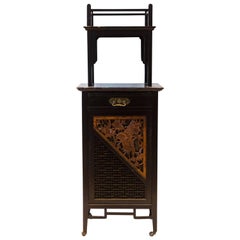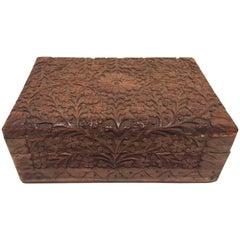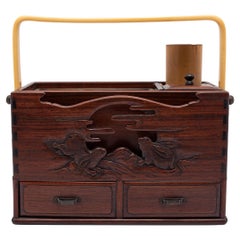Puritan Values More Asian Art, Objects and Furniture
1
to
1
1
1
1
1
1
1
1
1
1
1
1
1
By Edward William Godwin
Located in London, GB
Anglo Japanese ebonised purdonium.
Attributed to E. W. Godwin.
Probably made by William Watt.
The square section...
Category
Antique Late 19th Century English Arts and Crafts More Asian Art, Object...
Materials
Fruitwood, Walnut
Related Items
By Rajhastani
Located in North Hollywood, CA
Hand-carved Anglo Raj early 20th century carved wood box richly decorated overall with arabesques and floral car...
Category
Early 20th Century Indian Anglo Raj Decorative Boxes
Materials
Sandalwood
Located in Chicago, IL
This wooden box is a Japanese tabako-bon, or 'tobacco tray,' used to store tobacco a...
Category
Early 20th Century Japanese Taisho Snuff Boxes and Tobacco Boxes
Materials
Bamboo, Bakelite, Hardwood
Located in San Francisco, CA
An exquisite late 1970s Asian black cerused wood wall mirror with relief carve...
Category
Vintage 1970s American Japonisme Wall Mirrors
Materials
Mirror, Wood, Paint
H 53 in W 28.63 in D 0.75 in
Located in North Hollywood, CA
Antique Anglo-Indian quill box handcrafted and decorated with porcupine quills and bone dots.
Made in Ceylon wh...
Category
Early 20th Century Sri Lankan Anglo-Indian Decorative Boxes
Materials
Wood
Located in North Hollywood, CA
Nice and unusual Indian Mughal style large decorative box, filigree and carved horn.
Anglo-Indian footed domed box with exceptional engraved details throughout with filigree and carved veneered bone plaques with arabesque carving.
Vizagapatam, late 19th century.
History of the Anglo-Indian Boxes
Beginning in the early part of the 18th century, Indian artisans made what came to be known as Anglo-Indian boxes for the English residents living in India, who eventually brought or sent them back to England. At the beginning of the 19th century, India began exporting these boxes commercially, although not in any significant numbers until the 1850s. People valued them so highly that manufacturers of tins copied the designs on them in the late 19th and early 20th century.
Anglo-Indian boxes fall into four groups: Rosewood or ebony boxes inlaid;
sandalwood boxes veneered; sandalwood boxes covered with Sadeli mosaic; and carved boxes often combined with Sadeli mosaic/
The first two categories came from Vizagapatam in East India while the last two came from Bombay in West India.
English traders discovered the rich woods and intricate workmanship of Indian artisans, so colonial government officials began to recognize the work of the Indian artists and craftsmen as a source for satisfying the need for furniture and boxes, which would both serve to enhance English households in India. This gave rise to the cabinetmaking workshops in Vizagapatam between Calcutta and Madras.
Craftsmen made the first boxes to be decorated with Sadeli mosaic of rosewood or ebony, incised to give further definition to the decoration, directly inlaid into the wood. The shape of the early boxes was either sloping at the front with a flatter section at the back, reminiscent of English writing slopes, or rectangular. Artisans inlaid the borders with stylized floral scrolls and the centers with a single floral motif following a circular or oval symmetrical or asymmetrical pattern. The edging was ornamental and protective, both helped protect the end grain against the weather.
Made in Vizagapatam, situated on the south east coast of India, near Madras
These exotic boxes...
Category
Antique Late 19th Century Indian Anglo Raj Decorative Boxes
Materials
Wood
By Rajhastani
Located in North Hollywood, CA
Fine antique Anglo-Indian hand carved wooden jewelry box inlaid.
A...
Category
Antique Late 19th Century Indian Agra Decorative Boxes
Materials
Wood
Located in North Hollywood, CA
19th century Anglo-Indian wooden box fitted with various compartments finely hand carved.
The top is finely hand carved with the Taj Mahal.
The interior with removable hand carved nine-lidded compartments, the front cover has a mirror, the whole exhibiting very fine workmanship.
This fine late Victorian Anglo-Indian box from India is in great condition for it age.
A beautiful example of an Anglo-Indian fine art...
Category
Antique Late 19th Century Indian Anglo-Indian Decorative Boxes
Materials
Sandalwood
Located in South Burlington, VT
Japan a beautiful large hand carved Tsukubai Water Basin "Natsume" (tea container) shape, granite, Taisho period...
Category
Early 20th Century Japanese Taisho Garden Ornaments
Materials
Granite
Located in South Burlington, VT
Love Birds and Poppies
This is an original and beautiful hand-painted and hand incised fall front desk. This unique work of art is hand-painted on front with a roundel of three vibrant and colorful birds against a mountain scape and bouquets and runners of red poppies and greenery on remainder front perimeters, the sides and back are plain.
Inside we find a fitted interior with one drawer and pigeonholes. Two simple shelves...
Category
Early 20th Century American Arts and Crafts Desks
Materials
Wood
Located in Atlanta, GA
A fan shape black lacquer tray from Japan circa 1910-30s, late Meiji to early Showa era. Elaborated decorated with a bundle of yomogi blossom in a very fine Maki-e technique using both gold and silver powders. There is a Japanese symbol on the top left, which represents yomogiu, stemming from yomogi (蓬), a wild plant that belongs to the chrysanthemum family and widely grown in Japan.
This name yomogui is from a scene in the Tale of Genji...
Category
Early 20th Century Japanese Japonisme Lacquer
Materials
Lacquer
Located in Amsterdam, Noord Holland
Fabulous Japanese earthenware Satsuma Belt Buckle Bird decoration. Meiji period, 19t...
Category
Antique 19th Century Japanese More Asian Art, Objects and Furniture
Materials
Porcelain
H 0.52 in W 1.66 in D 2.21 in
Located in Milano, IT
Round plate made of bronze and cloisonné enamel designed in China in the 20th century.
This plate is made of br...
Category
Antique Early 1900s Chinese Chinese Export Antiquities
Materials
Bronze


